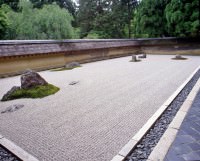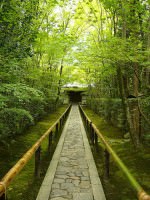
There is no doubt the Japanese have an extraordinary sense of aesthetics. This is evident from their traditional, colorful, silken kimonos to their trend-setting modern clothing designs, the stylized theatrical arts of Kabuki, Noh and Bunraku and their elegant but simple Ikebana floral arrangements. But perhaps this sense of aesthetics is no more evident than in Japanese gardens. The simple, minimalistic approach in restrictive, compact spaces belies the graceful results, making Japanese gardens the perfect place to contemplate the existence of nature and the nature of existence. To the casual visitor, a Japanese garden may “look pretty”. But with just a rudimentary study, the layers can be recognized and peeled back to lead to a more complete appreciation.
Japanese gardens are rooted in two traditions: an indigenous, prehistoric tradition in which patches of graveled forest or pebbled beach were dedicated to nature spirits; and a tradition from China that included elements such as ponds, streams, waterfalls, rock compositions and a variety of vegetation. We will trace the development and blending of these two traditions as well as the inclusion of new features that allowed Japanese gardens to reach new heights of sophistication.
Prehistoric
The precursor of the Japanese garden was the sanctified zones clearly distinguished from the natural order of its surroundings by emptying and marking. These areas were simple pebble-covered plots, created for ceremonies honoring spirits believed to have come from heaven or from across the sea. These pebbled plots later developed into the graveled courtyards associated with chief’s houses and Shinto Shrines.
Nara Period (645-794)
Formal garden designs were introduced from China along with Buddhism in the seventh century. The primary features of these gardens included a pond, with islands and rock groupings. These gardens were heavily influenced by their Chinese prototypes. No gardens from the Nara period remain, but paintings illustrate their design.
Recent excavations near Nara have unearthed proof of a river-style garden. This garden style featured a meandering stream, punctured with numerous rock outcroppings that collected at the end of its course into a pond. By this time, gardens had come to serve a primarily secular role. The nobility, who fashioned their gardens with the help of artisans and gardeners, created environments for refined pleasures. Often extensive in size, these gardens demonstrated that the art of Japanese garden design had already achieved admirable sophistication.
Heian Period (794-1185)
Because Chinese contact was limited during this time, garden design evolved in accordance with Japanese tastes and values, and provided a setting to pursue aesthetic interests and experience nature. Ponds were initially a minor component, but eventually became the dominant feature. Many garden ponds were used for pleasure-boating in Chinese-style boats.
Gardens were built around the Imperial court buildings by aristocrats. The garden represented paradise, and the delights of court life were played out on its shores. Garden components served both functional and symbolic purposes. Rocks, trees and plants may help to support an earthen bank. But at the same time, a rock grouping, plant or island referred to a literary past. For example, a tortoise-shaped island symbolized long life. Groupings of rocks and plants might conjure poetic references to famous sites in Japan, such as Matshushima. To the informed observer steeped in literature and philosophy, gardens were a portal to places real and mythical, and places distant and near.
During the eleventh century, a compilation of gardening principles appeared as a book called the Sakuteiki. The Sakukeitei is the oldest known written document of gardening in Japan, and yields insights into the nature and intentions of the aristocratic pleasure gardens.
Kamakura Period (1185-1333)
Two ethics dominated the Kamakura period; the cult of the Samurai and the related rise of Zen Buddhism as a guiding doctrine for monk and warrior. Zen Buddhism has exerted profound effect on Japanese arts and culture, and gardens also yielded to the Zen values.
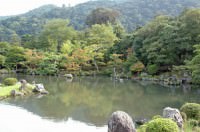
Gardens evolved from a play area for the privileged into a vehicle for something more profound. Zen thinking proposed the garden as an aid to meditation – an environment to look upon and then within. Initially during the early Kamakura period, gardens still drew many design methods from the Heian Period, however, over time gardens began to reflect the changes propelled by Zen. A good example of this is the garden at Tenryu-ji, built in 1270. This garden includes a large pond nestled at the foot of hill consistent with the Heian court style. However, the rock outcroppings around the pond are decidedly more vertical than its horizontal predecessors.
During the Kamakura period, the ineffective Imperial Court gave way to the new warrior class (the Samurai). Zen teaches a philosophy of austerity; with simple desires and means. Opulence mattered little. The impotence of the imperial court in Kyoto clearly represented the weakness bred by extravagance and lavish living. In keeping with Zen thinking, from the 14th century on, the number of materials used in the garden would be continually pared down from the secular pleasure gardens for the Heian nobility. The purpose of the these Zen gardens was to aid in meditation.
Muromachi Period (1392-1573)
The Kamakura period saw the rise of the Minamoto and Hojo clans who established a shogunate at Kamakura near Tokyo. However, due to economic problems, alliances between opposing political and military factions and decay from within these clans lost control of Japan almost as soon as they gained control. Late in the 14th century, the power base shifted once again.
The Ashikaga clan eclipsed the Kamakura government, and the new rulers returned to Kyoto. Along with the power shift, came another shift in garden aesthetics. The Heian period, the golden light in the dim past, shone as the apogee of Japanese art and culture. At the same time, the simplicity of the Zen gardens reached its pinnacle. The evolution and resulting popularity of the tea ceremony influenced garden designs as settings for retreats from the everyday world. Whether restricted to rock and sand, or allowed to luxuriate in more elaborate plantings, the gardens of the Muromachi period produced some of the most strikingly original garden forms of all time, including stroll gardens, dry gardens and tea gardens.
Stroll Gardens
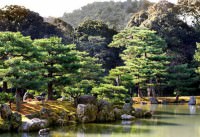
Zen gardens, while designed to facilitate meditation, removed the observer from the garden. The new Muromachi stroll gardens, much like their Heian period predecessors, returned viewers to the garden itself rather than confining them to a veranda. The garden was not observed from a single point, but rather surveyed, traversed, smelled, listened to and appreciated from many different positions. Together with richly planted landscapes, this design emerged as a leading garden form. Two of the best examples of this garden design from the Muromachi period are Kinkaku-ji (the Golden Pavilion) and Ginkaku-ji (the Silver Pavilion).
Dry Gardens
In contrast to the copiously planted materials of the stroll gardens, was the simplicity of the dry Zen garden. While the dry garden existed previously for centuries, many gardens today considered the best representatives of the Zen aesthetic are a product of this period.
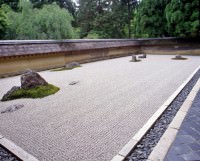
During this period, many religious compounds extended their size and influence by grouping numerous sub-temples under the jurisdiction of a single abbot. The walled enclosures were normally small with little or no room for growth. Although space for gardens is small, few garden forms can rival the dry garden for its sense of universe within four walls. Ryoan-ji and Daisen-in (a sub-temple of Daitoku-ji), are the foremost representatives of this type with their precisely raked gravel sand and dynamically grouped stones.
Tea Gardens
Accompanying the increased popularity of the tea ceremony came a garden setting to enhance the experience. At first only a room of a villa or temple was devoted to the ceremony, but in time that room became a detached house. The tea garden, or roji, differed from other gardens in that it led to the tea ritual. It was a vehicle for transmission more than an elaborate landscape in and of itself. The roji carried the guests from the everyday workday to that of tea. The garden presented a graduation of order from more formal arrangements of planting at the entrance to seemingly informal and less structured near the tea house.
Edo period (1600-1868)
The Edo Period marked another government, but this time, as opposed to the other military governments, this government was here to stay. After unifying Japan, Tokugawa Ieyasu and his successors enacted political and cultural laws that cemented their control over Japan. They created a feudal-like system with the most trustworthy feudal lords given the most land, and thus more power. Because the Edo period was very peaceful, the feudal lords had time and money to sponsor the arts, and garden design was one of the many activities they participated in.
Once again, garden designers during the Edo period turned an eye to the past. Using the Heian period paradise gardens as their basis, Edo period gardens continued the trend of involving participants in the garden, while at times manipulating the participant using new techniques to create the desired effect, including diagonal approaches, ‘hide and reveal’ and shakkei (borrowed scenery).
Diagonal approaches
Unlike Western garden components which are approached frontally, Japanese garden components of this period were approached obliquely, or diagonally. When viewed this way within the garden setting, the component seems less a destination and more a feature of the landscape. The garden at Versailles, created during this period, is an example of garden design using straight lines and exact geometry in the extreme. This garden style manifested the king’s power over nature and the people. The model of nature in the Japanese gardens of this time was nature itself.
Hide and Reveal
Hide and reveal fixes attention on one item as one stage in continuous procession. Rather than follow a straight line, the path veers; first left to appreciate a tree, then perhaps right to glimpse a rock grouping on the shore of a pond. Irregular placement of stepping stones in the path forces the guests to look down to watch their step. And when they look up, a new view unfolds. Hills, hedges or trees and other items were added to a garden to block the view of a certain area of a garden until the observer moved to the next viewing spot.
Shakkei or Borrowed Scenery
Shakkei, or Borrowed Scenery,while used previously was used during the Edo period with dramatic results, despite its deceptively simple basis. The garden occupies the foreground of the view. Hedges may be planted in the middle ground to obstruct the view of a house or other inappropriate features effecting a smooth transition from the foreground to the background features. The distant background is incorporated into the garden design almost as if it was created for that sole purpose, while making the garden appear larger. In other words, Japanese garden designers used perspective just as Renaissance painters in Europe.
Modern Times
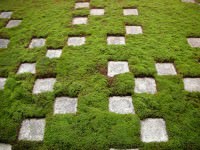
After the war, government programs were created to concentrate on reconstructing industry and housing, leaving little funding for recreational purposes. Garden designers after the war, had few materials to work with. But many made the best of the situation. A perfect example of this is at Tofuku-ji Temple.

